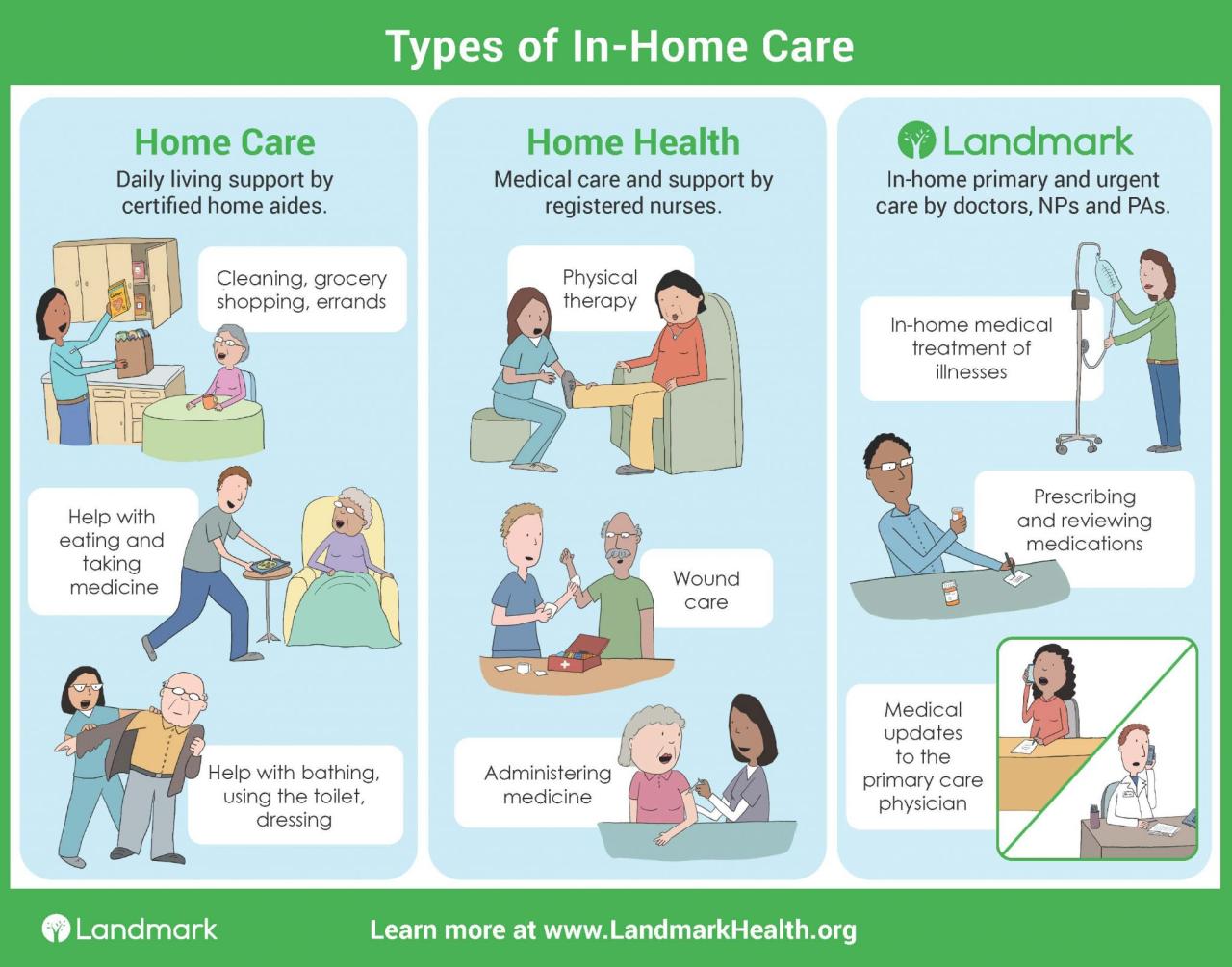In-Home Primary Care: The Future of Interior Health Tech
Kicking off with In-Home Primary Care: The Future of Interior Health Tech, this opening paragraph is designed to captivate and engage the readers, setting the tone for a detailed exploration of the topic.
The following paragraphs will delve into the concept, benefits, technologies, and challenges of in-home primary care, along with the role of interior health tech in transforming healthcare delivery.
Overview of In-Home Primary Care

In-home primary care refers to medical services provided in the comfort of a patient's home, bringing healthcare directly to the individual. This approach is gaining significance in healthcare as it offers personalized and convenient care for patients who may have difficulty accessing traditional healthcare settings.
Benefits of In-Home Primary Care
- Improved Patient Outcomes: Patients often experience better health outcomes and reduced hospitalizations when receiving care at home.
- Increased Patient Satisfaction: Patients appreciate the personalized attention and convenience of in-home primary care.
- Reduced Caregiver Burden: In-home care can alleviate the stress on caregivers by providing professional medical support at home.
- Enhanced Coordination of Care: Healthcare providers can collaborate more effectively to deliver comprehensive care to patients in their homes.
Technologies Used in In-Home Primary Care
In-home primary care services leverage various technologies to enhance patient care and communication. Some examples include:
- Telehealth solutions for virtual consultations and monitoring.
- Remote monitoring devices for tracking vital signs and health metrics.
- Mobile applications for scheduling appointments and accessing health information.
- Electronic health records for seamless sharing of patient information among care team members.
Adoption of In-Home Primary Care
The adoption of in-home primary care is on the rise, driven by the desire to improve patient outcomes and reduce healthcare costs. According to a report by the American Academy of Home Care Medicine, the number of home-based primary care programs in the US has been steadily increasing in recent years.
This trend is expected to continue as more healthcare organizations recognize the benefits of delivering care directly to patients' homes.
Interior Health Tech in In-Home Primary Care

In the realm of healthcare, interior health tech refers to the innovative devices and tools utilized within the home setting to deliver primary care services. This emerging field is revolutionizing the way patients receive medical attention by bringing advanced technology directly to their doorsteps.
Role of Interior Health Tech in Delivering Healthcare
Interior health tech plays a crucial role in delivering healthcare within homes by enabling healthcare providers to monitor patients remotely, administer treatments, and communicate effectively with individuals who may have limited mobility or access to traditional healthcare facilities. This technology enhances the quality of care provided to patients by ensuring timely interventions and personalized treatment plans.
Impact on Patient Outcomes and Experiences
The integration of interior health tech in in-home primary care has shown significant improvements in patient outcomes and experiences. Patients benefit from increased convenience, reduced hospital readmissions, and enhanced communication with their healthcare providers. This technology empowers patients to take control of their health and well-being while receiving the necessary medical support from the comfort of their homes.
Key Devices and Tools in Interior Health Tech
Some of the key devices and tools used in interior health tech for in-home primary care include remote monitoring devices, telemedicine platforms, medication management systems, and wearable health trackers. These tools enable healthcare providers to remotely assess patients' vital signs, conduct virtual consultations, ensure medication adherence, and track health metrics in real-time.
Success Stories in Interior Health Tech
Numerous success stories and case studies highlight the effectiveness of interior health tech in improving patient outcomes and reducing healthcare costs. For example, a study conducted on the use of remote monitoring devices for patients with chronic conditions showed a significant decrease in emergency room visits and hospitalizations.
Similarly, telemedicine platforms have enabled patients in rural areas to access specialist consultations without the need for travel, leading to better health outcomes and increased patient satisfaction.
Challenges and Solutions
In implementing in-home primary care with interior health tech, there are various challenges that healthcare providers may encounter. These challenges can range from technological barriers to resistance from patients or staff. However, with the right strategies and solutions, these challenges can be effectively addressed to ensure successful integration of interior health tech in in-home primary care services.
Common Challenges Faced in Implementing In-Home Primary Care with Interior Health Tech
- Lack of infrastructure: Setting up the necessary technology infrastructure in patients' homes can be a major hurdle.
- Data security and privacy concerns: Ensuring the confidentiality of patient information when using interior health tech is crucial.
- Resistance to change: Patients and staff may be hesitant to adopt new technologies, leading to potential barriers in implementation.
Proposed Solutions or Strategies to Address These Challenges
- Invest in training and education: Providing comprehensive training to staff and patients on how to use interior health tech can help alleviate resistance to change.
- Implement robust data security measures: By incorporating encryption and other security protocols, healthcare providers can address privacy concerns effectively.
- Collaborate with technology experts: Working with IT professionals can help in setting up the necessary infrastructure for in-home primary care services.
Comparing Different Approaches to Integrating Interior Health Tech in In-Home Primary Care
- Remote monitoring: Utilizing wearable devices and sensors to track patients' health remotely.
- Telemedicine: Conducting virtual consultations and follow-ups using video conferencing technology.
- Mobile health apps: Implementing apps that allow patients to schedule appointments, access medical records, and communicate with healthcare providers.
The Role of Training and Education in Overcoming Challenges Related to Interior Health Tech Adoption
- Continuous training: Providing ongoing education to staff and patients to ensure they are proficient in using interior health tech.
- Customized training programs: Tailoring training sessions to the specific needs and preferences of different user groups.
- Engaging with experts: Collaborating with technology vendors and consultants to develop specialized training modules.
Ethical and Privacy Considerations
In the realm of in-home primary care and interior health tech, ethical considerations and privacy concerns play a crucial role in shaping the delivery of healthcare services. As technology continues to advance, it is essential to navigate the complex landscape of ethical dilemmas and privacy breaches that may arise in this context.
Ethical Considerations
Ethical considerations in in-home primary care revolve around issues such as patient autonomy, beneficence, non-maleficence, and justice. Ensuring that patients have the right to make informed decisions about their care, while also balancing the need to provide beneficial and non-harmful treatments, is paramount in this setting.
Healthcare providers must navigate these ethical principles while leveraging interior health tech to improve patient outcomes.
- Respect for patient autonomy: Upholding the right of patients to make decisions about their care, even in the presence of technology that may influence these choices.
- Beneficence and non-maleficence: Striving to provide benefits to patients through the use of technology, while also avoiding harm or potential risks associated with its implementation.
- Justice: Ensuring fair and equitable access to in-home primary care services, regardless of socioeconomic status or other factors.
Privacy Concerns
Privacy concerns related to the use of technology in home-based healthcare include issues surrounding data security, confidentiality, and the potential for breaches that could compromise patient information. As interior health tech collects and processes sensitive data, safeguarding patient privacy becomes a critical priority for healthcare providers and technology developers.
- Data security: Implementing robust security measures to protect patient data from unauthorized access or cyber threats.
- Confidentiality: Safeguarding the privacy of patient information and ensuring that it is only accessed by authorized individuals for legitimate purposes.
- Privacy breaches: Mitigating the risk of privacy breaches that could result in the exposure of sensitive health data to unauthorized parties.
Regulations and Guidelines
Regulations and guidelines governing the ethical use of interior health tech in in-home primary care vary by jurisdiction but often include standards related to data protection, informed consent, and patient rights. Healthcare providers must adhere to these regulations to ensure that the use of technology in patient care is conducted ethically and in accordance with legal requirements.
- Compliance with data protection laws: Adhering to regulations such as the Health Insurance Portability and Accountability Act (HIPAA) to protect patient data from unauthorized disclosure.
- Informed consent: Obtaining explicit consent from patients before implementing interior health tech in their care and ensuring that they understand the implications of using such technology.
- Patient rights: Upholding the rights of patients to privacy, confidentiality, and autonomy throughout the delivery of in-home primary care services.
Ethical Dilemmas and Privacy Breaches
Examples of ethical dilemmas or privacy breaches that may arise in the context of in-home primary care include issues such as unauthorized access to patient data, breaches in telehealth confidentiality, and the potential for biases in algorithms used for clinical decision-making.
Healthcare providers must remain vigilant in addressing these challenges to uphold ethical standards and protect patient privacy in the era of interior health tech.
Last Point

In conclusion, the future of interior health tech in in-home primary care presents a promising landscape of enhanced patient care and innovative solutions.
FAQ Summary
What are some common challenges faced in implementing in-home primary care with interior health tech?
Some common challenges include technological limitations, privacy concerns, and resistance to change among healthcare providers.
How can these challenges be effectively addressed?
Implementing comprehensive training programs, ensuring data security measures, and fostering a culture of innovation can help address these challenges.
What are the key devices or tools used in interior health tech for in-home primary care?
Key devices include remote monitoring systems, wearable health trackers, telemedicine platforms, and smart medication dispensers.
What ethical considerations surround in-home primary care and interior health tech?
Ethical considerations include patient autonomy, data confidentiality, informed consent, and equitable access to care.
Are there regulations governing the ethical use of interior health tech in in-home primary care?
Yes, regulations such as HIPAA in the United States and GDPR in Europe set standards for data protection and privacy in healthcare.